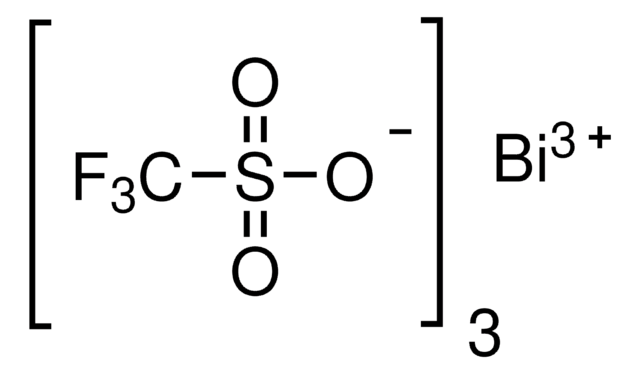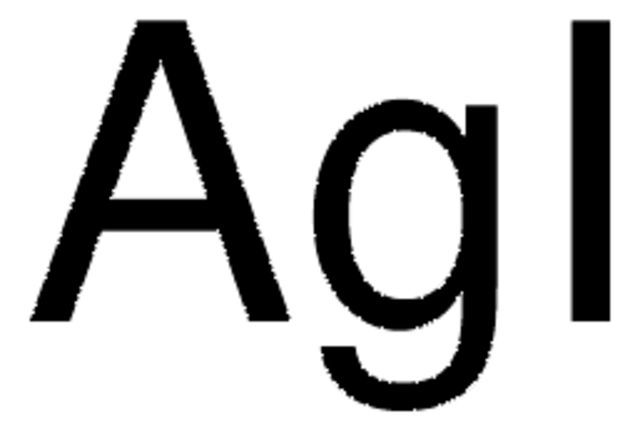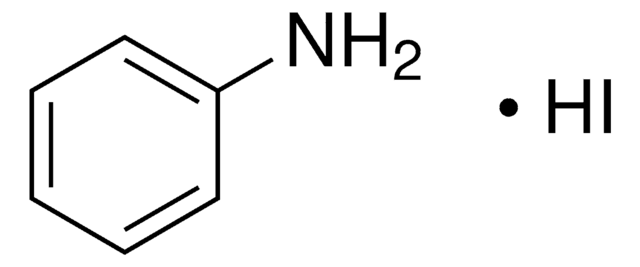341010
Bismuth(III) iodide
99%
Synonym(s):
Bismuth triiodide, Triiodobismuthane
Sign Into View Organizational & Contract Pricing
All Photos(4)
About This Item
Empirical Formula (Hill Notation):
BiI3
CAS Number:
Molecular Weight:
589.69
EC Number:
MDL number:
UNSPSC Code:
12161600
PubChem Substance ID:
NACRES:
NA.22
Recommended Products
Quality Level
Assay
99%
form
powder
reaction suitability
core: bismuth
reagent type: catalyst
mp
408 °C (lit.)
density
5.78 g/mL at 25 °C (lit.)
SMILES string
I[Bi](I)I
InChI
1S/Bi.3HI/h;3*1H/q+3;;;/p-3
InChI key
KOECRLKKXSXCPB-UHFFFAOYSA-K
Looking for similar products? Visit Product Comparison Guide
Related Categories
Application
Bismuth(III) iodide or Bismuth triiodide are nontoxic and hence they are used as environmentally friendly catalysts. It can be used as a catalyst in the:
- Chemoselective deprotection of acetals and ketals in water.
- Synthesis of polysubstituted guanidines by guanylation reaction of thioureas with amines.
- Sulfenylation of carbonyl compounds.
Signal Word
Danger
Hazard Statements
Precautionary Statements
Hazard Classifications
Eye Dam. 1 - Skin Corr. 1B
Storage Class Code
8A - Combustible corrosive hazardous materials
WGK
WGK 3
Flash Point(F)
Not applicable
Flash Point(C)
Not applicable
Personal Protective Equipment
dust mask type N95 (US), Eyeshields, Gloves
Choose from one of the most recent versions:
Already Own This Product?
Find documentation for the products that you have recently purchased in the Document Library.
Customers Also Viewed
Bismuth (III) Halides and Sulfate as Highly Efficient Catalyst for the Sulfenylation of Carbonyl and Related Compounds1
Komatsu N, et al.
Synlett, 1995(09), 984-986 (1995)
The first bismuth (III)-catalyzed guanylation of thioureas
Cunha S and Rodrigues Jr MT
Tetrahedron Letters, 47(39), 6955-6956 (2006)
Environmentally friendly organic synthesis using bismuth compounds: bismuth (III) iodide catalyzed deprotection of acetals in water
Bailey AD, et al.
Tetrahedron Letters, 49(4), 691-694 (2008)
Wenhua Bi et al.
Chemical communications (Cambridge, England), (44)(44), 5743-5745 (2008-11-15)
The dehydration of a iodobismuthate hybrid built up from Bi(4)I(16) clusters and protonated L-cystine molecules involves an unprecedented reversible dynamic structural change in the solid state leading to 1D BiI(4) chains and 1D helical molecular chains, highlighting the templating effect
Jie Sun et al.
Spectrochimica acta. Part A, Molecular and biomolecular spectroscopy, 79(5), 904-908 (2011-05-10)
A novel series of Ge-Te-BiI(3) chalcogenide glasses were prepared by traditional melt-quenching method and the glass-forming region was determined. Properties measurements including density, Vis-NIR and infrared (IR) transmission spectra with FTIR, XRD, DSC were adopted to analyze the composition, structure
Our team of scientists has experience in all areas of research including Life Science, Material Science, Chemical Synthesis, Chromatography, Analytical and many others.
Contact Technical Service












